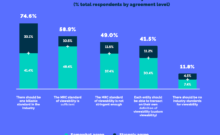“PLEASE don’t leave us.” From the dozens of e-mails in people’s inboxes, begging them to give their consent to be sent further messages, you could deduce that the senders of newsletters and the like are hardest hit by the European Union’s tough new privacy law, the General Data Protection Regulation (GDPR), which goes into effect on May 25th. But the main loser may well be an industry that few have ever heard of but most have dealings with every day: advertising technology, or ad tech. In fact, the GDPR would probably not exist at all were it not for this collection of companies, which have an insatiable hunger for personal data.
Ad tech emerged because advertising is the internet’s default business model. Since targeted ads tend to be more efficient and targeting requires personal data (sites previously visited, searches in online stores and the like), these data became the fuel of a new industry to automate online advertising. It is so complex that even experts often resort to what is known as “LUMAscape”, a collection of maps of the business packed with logos put together by Luma Partners, a bank. It lists hundreds of firms in 18 different subcategories.
One cause for this fragmentation is the generosity of over-optimistic venture capitalists, who have backed even the most unlikely ad-tech ideas. Another is the nature of the beast: many cogs have to mesh to match people and ads in real-time. The fact that personal data are widely shared with lots of companies creates even more business complexity—but also makes the system a favourite target of privacy advocates.
Yet the “ad-tech bubble” has been deflating for some time, says Brian Wieser of Pivotal, a research firm. The industry thought that consumers would welcome “relevant” ads, but as these got more intrusive and creepy, people reacted by installing ad-blockers. Both Facebook and Google, ad-tech ecosystems unto themselves, have grabbed ever more ad dollars, leaving slim pickings for rivals. As a result, the industry was already consolidating.
Read More At The Original Article: www.economist.com









